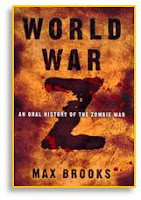World
War Z is a terrific movie that risks losing an audience of people who would
enjoy it if they understood that it is more about a worldwide pandemic than zombies. It’s more Contagion than Night of the Living Dead. What’s the difference? It’s simple.
Your classical zombie is a dead person who rises from the
grave to lurch and jerk its rotting body your way in order to eat your
brain. These zombies are slow, stupid,
and stuck on moving in one direction. They
wear stained and tattered burial clothes and tend to shed body parts. Typical zombies are easy to outrun or avoid,
but dangerous in large groups.
WWZ zombies, once infected, convert in 10 seconds. While they are not truly dead in terms of the
body ceasing to function, they are no longer themselves and their one goal is
to bite other humans. If you find this
an improbable scenario, consider rabies.
In the final
stages of rabies, the infected animal is essentially dead but its body has
been taken over by the virus. The rabies virus then forces the animal into aberrant behavior that serves only one
purpose—to spread the virus to other mammals.
That happened just last week here
in Massachusetts where a normally reclusive bobcat
attacked a man repeatedly and persistently, even after he had shot it.
 |
| Rabies Virus |
Only the timeframe changes.
Rabies normally incubates for two to 12 weeks but the incubation period
can be as short as four days. The WWZ
incubation period is from 10 seconds to just under an hour. No biggie.
It’s a disease. It’s transmitted
through a bite. It spreads
exponentially. No one is safe.
Prepare to run—fast! The infected, never having been subjected to real bodily death, run lickety-split and they have much better reaction time than any ghoul.
Prepare to run—fast! The infected, never having been subjected to real bodily death, run lickety-split and they have much better reaction time than any ghoul.
The second difference is that what remains of world
government is trying to both isolate the healthy and find a cause. This isn’t a few survivors huddled in a cabin
trying to hold off the lurching undead. Or one scientist holed
up in what’s left of Manhattan with his dog. It’s what—I hope—would happen should a real
fast-moving, rapidly mutating virus gain a foothold. The military takes charge, sets up perimeters
and keeps the scientists safe while they search for Patient Zero. Governments cooperate. Old enemies join forces to protect themselves
from the infected. Strangers help.
In fact, the most effective part of the movie is at the end
when the big set pieces of mass attacks are over and the story comes down to a
few people struggling to find the answer.
That’s where all the real eye-popping, teeth-clicking suspense comes in
and it’s done well. If you can imagine
Run Silent, Run Deep combined with Die Hard, you get a sense of how suspenseful the ending
is.
I went to the theater with some trepidation, however. This story is
based on the book by Max Brooks (son of Mel Brooks and Anne Bancroft) but the
movie relates what happened before the book starts so a lot of original writing
needed to be done. The screenplay for WWZ is credited to no
fewer than four writers and that’s never a good thing. The final product of such collaboration is
usually a mish-mash of ideas that don’t mesh well and result in a disjointed,
incomprehensible story. But the writers for
WWZ are Damon Lindelof, Drew Goddard, Matthew Michael Carnahan, and J. Michael Straczynski and that
makes a big difference. These guys all know
their way around a good tight script and they all have a great track
record.
Although WWZ had its problems during production, the final
result is a highly enjoyable film and I recommend it strongly. See it in 3D.


No comments:
Post a Comment